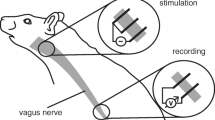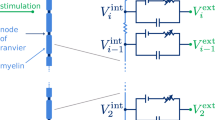Abstract
The aim of the study was to investigate how variable fibre geometry influences the excitation and blocking threshold of an undulating peripheral nerve fibre. The sensitivity of the excitation and blocking thresholds of the nerve fibres to various geometric and stimulation parameters was examined. The nerve fibres had a spiral shape (defined by the undulation wavelength, undulation amplitude and phase), and the internodal length varied. Diameter-selective stimulation of nerve fibres was obtained using anodal block. Simulation was performed using a two-part simulation model: a volume conductor model to calculate the electrical potential distribution inside a tripolar cuff electrode and a model of a peripheral undulating human nerve fibre to simulate the fibre response to stimulation. The excitation threshold of the undulating fibres was up to 100% higher than the excitation threshold of the straight fibres. When a nerve was stimulated with long pulses, which are typically applied for anodal block (>400μs), the blocking threshold of the undulating fibres was up to four times higher than the blocking threshold of the straight fibres. Dependencies of the excitation threshold on geometric and stimulation parameters were the same as for a straight fibre. Dependencies of the blocking threshold on geometric and stimulation parameters were different compared with a straight fibre. Owing to the fibre undulation and variable internodal length, the blocking threshold and the minimum pulse duration to obtain anodal block were generally different in the proximal and distal directions. Owing to variable fibre geometry, the excitation threshold varied by up to ±40% of the mean value, and the blocking threshold varied by up to ±60% of the mean value. Owing to undulation, the blocking threshold of large fibres could be higher than the blocking threshold of small-diameter fibres, even if they had the same geometry. The results indicate that, during skeletal muscle stretching and contracting or during variation in joint angle, the excitation and blocking thresholds of the nerve fibres change owing to variations in fibre geometry. A straight fibre model could be too simple for modelling the response of peripheral nerve fibres to electrical stimulation.
Similar content being viewed by others
References
Behse, F. (1990): ‘Morphometric studies on the human sural nerve’,Acta Neurolog. Scand., Supplementum,82
Byl, C., Puttlitz, C., Byl, N., Lotz, J., andTopp, K. (2002): ‘Strain in the median and ulnar nerves during upper-extremity positioning’,J. Hand Surg. [Am.],27, pp. 1032–1040
Clarke, E., andBearn, J. G. (1972): ‘The spiral nerve bands of Fontana’,Brain,95, pp. 1–20
Haninec, P. (1986): ‘Undulating course of nerve fibres and bands of Fontana in peripheral nerves of the rat’,Anat. Embryol. (Berl.) 174, pp. 407–411
Henneman, E. (1981): ‘Recruitment of motoneurons: the size principle’, inDesmedt, J. E. (Ed): ‘Motor unit types, recruitment and plasticity in health and disease’,Prog. Clin. Neurophysiol.,9, pp. 26–60
Kwan, M. K., Wall, E. J., Massie, J., andGarfin, S. R. (1992): ‘Strain, stress and stretch of peripheral nerve. Rabbit experimentsin vitro andin vivo’,Acta Orthop. Scand.,63, pp. 267–272
Rijkhoff, N. J. M., Holsheimer, J., Koldewijn, E. L., Struijk, J. J., van Kerrebroeck, P. E., Debruyne, F. M., andWijkstra, H. (1994): ‘Selective stimulation of sacral nerve roots for bladder control: a study by computer modelling’,IEEE Trans. Biomed. Eng.,41, pp. 413–424
Schnabel, V., andStruijk, J. J. (1999): ‘Magnetic and electrical stimulation of undulating nerve fibres: a simulation study’,Med. Biol. Eng. Comput.,37, pp. 704–709
Schnabel, V., andStruijk J. J. (2000): ‘Calculation of the Electrical Field Induced by Magnetic Coils in a Multiple Cylinder Volume Conductor’, World Congress on Medical Physics and Biomedical Engineering. CD ROM.
Schnabel, V. (2001): ‘Mathematical models for magnetic stimulation of peripheral nerve’. PhD thesis, Center for sensory-motor interaction, Department of Medical Informatics a Image Analysis, Aalborg University, Denmark (ISBN: 87-90562-05-04)
Struijk, J. J., andSchnabel, V. (2000): ‘Influence of parameter variability on stimulus thresholds in nerve fibre model’, 5th Ann. Conf. IFESS. Aalborg, Denmark, pp. 245–248
Sunderland, S. (1990): ‘The anatomy and physiology of nerve injury’,Muscle&Nerve,13, pp. 771–784
Vučković, A., Rijkhoff, N. J., andStruijk, J. J. (2004): ‘Different pulse shapes to obtain small fibre selective activation by anodal blocking-a simulation study’,IEEE Trans. Biomed. Eng.,51, pp. 698–706
Wesselink, W. A., Holsheimer, J., andBoom, H. B. K. (1999): ‘A model of the electrical behavior of myelinated sensory nerve fibres based on human data’,Med. Biol. Eng. Comput.,37, pp. 228–235
Zvěřina, E., andŠprincl, L. (1979): ‘Fontana's spiral bands and undulating course of nerve fibres. Occurrence and clinical importance in man’,Cesk. Neurol. Neurochir.,42, pp. 333–339
Author information
Authors and Affiliations
Corresponding author
Rights and permissions
About this article
Cite this article
Vučković, A., Struijk, J.J. & Rijkhoff, N.J.M. Influence of variable nerve fibre geometry on the excitation and blocking threshold. A simulation study. Med. Biol. Eng. Comput. 43, 365–374 (2005). https://doi.org/10.1007/BF02345814
Received:
Accepted:
Issue Date:
DOI: https://doi.org/10.1007/BF02345814




